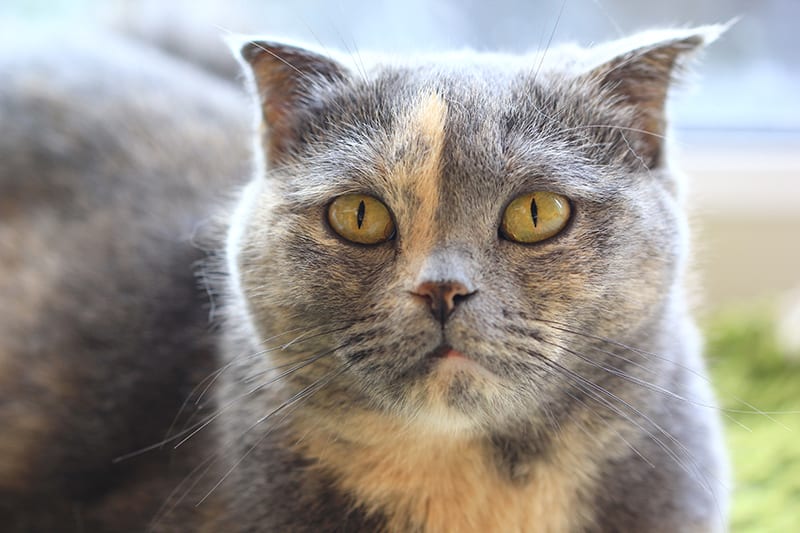Although cat urinary tract infections are rare compared to the occurrence of UTIs in dogs, older cats can experience a host of other urinary tract issues that cause similar symptoms. Today our Greensboro vets share the symptoms, causes and treatments for urinary tract infections and diseases in cats.
Urinary Tract Infection - Cat
Although urinary tract issues are often seen in cats, our feline friends are more prone to urinary tract disease than infections.
When cats do develop urinary tract infections it is often the case that they also suffer from endocrine diseases, such as hyperthyroidism and diabetes mellitus, and most of these cats are 10 years of age or older.
If your kitty is displaying symptoms of a urinary tract infection (see below) and is diagnosed with an infection such as cystitis your veterinarian will prescribe an antibacterial to help fight your cat's UTI.
The most common symptoms of urinary tract infections in cats include straining to urinate, reduced amounts of urine, not urinating at all, pain or discomfort when urinating, passing urine tinged with blood and urinating around the house, outside of the litter box.
If your cat is showing any of the symptoms listed above they may be suffering from a UTI but these symptoms could also be an indication of a feline lower urinary tract disease or FLUTD.
Feline Urinary Tract Disease - FLUTD
FLUTD, Feline lower urinary tract disease is actually an umbrella term that refers to numerous clinical symptoms. FLUTD can cause issues in your cat’s urethra and bladder, often leading the urethra to become obstructed, or preventing your cat's bladder from emptying properly. These conditions can be serious or even life-threatening if left untreated.
Urinating can be difficult, painful or impossible for cats suffering from FLUTD. They may also urinate more frequently, or in inappropriate areas outside their litter box (occasionally on surfaces that are cool to the touch such as a tile floor or bathtub).
Causes of Feline Urinary Tract Disease
FLUTD is a complex condition to diagnose and treat since there are multiple causes and contributing factors to this disease. Crystals, stones or debris can gradually build up in your cat's urethra - the tube connecting the bladder to the outside of your cat’s body - or bladder.
Some other common causes of lower urinary tract issues in cats include:
- Incontinence due to excessive water consumption or weak bladder
- Spinal cord issues
- Urethral plug caused by the accumulation of debris from urine
- Bladder infection, inflammation, urinary tract infection (UTI)
- Injury or tumor in the urinary tract
- Congenital abnormalities
- Emotional or environmental stressors
Urinary tract disease in cats is most often diagnosed in overweight, middle-aged cats who have little to no access to outdoors, eat a dry food diet or do not get enough physical activity, although cats of any age can get the condition. Male cats are also more prone to urinary diseases since their narrower urethras are more likely to become blocked.
Using an indoor litter box, emotional or environmental stress, multi-cat households or sudden changes to their everyday routine can also leave cats more vulnerable to urinary tract disease.
If your kitty is diagnosed with FLUTD it is essential to determine the underlying cause. FLUTD symptoms can be caused by serious underlying health issues such as bladder stones or infection to cancer or a blockage.
If your vet is unable to determine the cause of your cat's FLUTD, your kitty may be diagnosed with a urinary tract infection called cystitis which is inflammation of the bladder.
Symptoms of Feline Urinary Tract Disease in Cats
If your cat has FLUTD or a cat urinary tract infection you may notice one or more of the following symptoms:
- Inability to urinate
- Loss of bladder control
- Urinating small amounts
- Urinating more than usual or in inappropriate settings
- Avoidance or fear of litter box
- Strong ammonia odor in urine
- Hard or distended abdomen
- Cloudy or bloody urine
- Drinking more water than usual
- Excessive licking of genital area
- Lethargy
- Vomiting
It’s critical that any bladder or urinary issue be treated as early as possible. Delays in treatment could lead to your cat's urethra becoming partially or completely obstructed, which can prevent your feline friend from urinating.
The symptoms above indicate a serious medical issue that could quickly lead to kidney failure or rupture of the bladder. FLUTD can quickly be fatal if there is an obstruction that is not eliminated immediately.
Diagnosis of Feline Urinary Tract Disease
If you believe that your feline friend may be having problems with their lower urinary tract, contact your vet right away, especially if your cat is straining to urinate or crying out in pain.
Your vet will perform a complete physical exam to help assess your cat's symptoms and perform a urinalysis to get further insight into your cat's condition. Radiographs, blood work and a urine culture may also need to be done.
Cat Urinary Tract Infection Recovery
Urinary issues in cats can be complex and serious, so the first step should be to make an appointment with your veterinarian for immediate care. The underlying cause of your cat's urinary symptoms will dictate which treatment is prescribed, but may include:
- Increasing your kitty's water consumption
- Antibiotics or medication to relieve symptoms
- Modified diet
- Expelling of small stones through the urethra
- Urinary acidifiers
- Fluid therapy
- Urinary catheter or surgery for male cats to remove urethral blocks
Note: The advice provided in this post is intended for informational purposes and does not constitute medical advice regarding pets. For an accurate diagnosis of your pet's condition, please make an appointment with your vet.
Urinary tract infections and feline lower urinary tract disease are both conditions that require immediate veterinary care! Book an appointment with our Greensboro vets today if your feline friend is showing signs of a UTI.
Looking for a vet in Greensboro?
We're always accepting new patients, so contact our veterinary hospital today to book your pet's first appointment.
Related Articles View All
What happens during a routine pet exam?
Routine wellness exams are a proactive way to help safeguard your pet's long-term health and vitality. Why should you take your healthy pet to the vet? What happens during a pet health wellness exam? Find out.
How much does an emergency vet visit cost?
Emergency veterinary care can be costly, but planning ahead allows you to make decisions about your pet's care based on their needs rather than financial restrictions. Today, we look at the cost of emergency vet care, and how to be ready if your pet needs emergency treatment.
Does my cat have asthma?
The treatment for asthma in cats can seem daunting for many pet parents. But your veterinarian can lead you through the diagnosis and treatment process, to help get your cat breathing easier.


